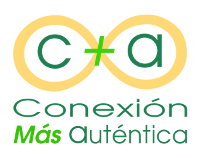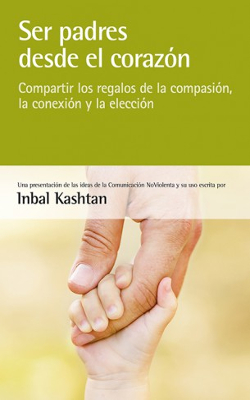Label: Texts CNV
my article “Combining Focusing and Nonviolent Communication”, translated into Japanese: Intersection of the focusing and the non-violent communication
9 February 2017.
Tags: Agenda actual, CNV, Interpersonal communication, Focusing community, Focusing, Focusing international, In English, My Classifieds, Texts CNV, Textos Focusing
Text in Spanish – Japanese – Click here to read in English
Focusing International Conference in Cambridge (United Kingdom) in July 2016 continues to bear fruit.
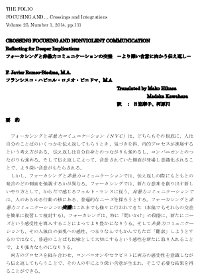 Today I have the honor to present the translation of my article “Combining Focusing and Nonviolent Communication. Reflecting deeper implications for” (appeared in 2014 in The Folio. A Journal for Focusing and Experiential Therapy) Japanese, with the suggestive title “Focusing and non-violent communication intersection of - towards the deeper implications tell-back -“.
Today I have the honor to present the translation of my article “Combining Focusing and Nonviolent Communication. Reflecting deeper implications for” (appeared in 2014 in The Folio. A Journal for Focusing and Experiential Therapy) Japanese, with the suggestive title “Focusing and non-violent communication intersection of - towards the deeper implications tell-back -“.
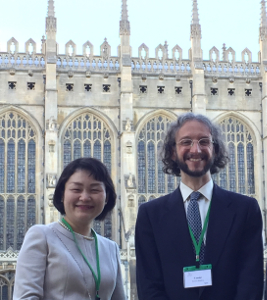
Con Madoka Kawahara (Kawahara circle).
Cambridge had the pleasure to meet Madoka Kawahara (Kawahara circle), Focusing training psychotherapist who had initiated the translation of the article a while back, already Mako Hikasa (Mako Hikasa), Focusing renowned Coordinator, which joined the project in its final phase translation. Our discussions from that meeting made the project proceed, and now there is this careful translation is available on the website Focusing Japanese Association (Japan Focusing Association), and I reproduce here with his permission.
From here I want to express my deep appreciation for their efforts and dedication (there have been many emails back and forth to clarify concepts and terms) so you can know this aspect of Focusing among many practitioners and professionals Focusing Japan.
In deep appreciation,
Cambridge 27th International Focusing Conference, which was held in (the UK)It is、It has brought a more abundant achievements。
 now、I、paper"Intersection of the focusing and the non-violent communication - deeper implications toward tell-back -"("Journal for focusing and experiencing therapy"The Folio. A Journal for Focusing and Experiential TherapyVol. 25, No. 1、2014I am honored to be posted on the year) has been translated into Japanese。
now、I、paper"Intersection of the focusing and the non-violent communication - deeper implications toward tell-back -"("Journal for focusing and experiencing therapy"The Folio. A Journal for Focusing and Experiential TherapyVol. 25, No. 1、2014I am honored to be posted on the year) has been translated into Japanese。

Madoka Kawahara
In Cambridge、Mr. counselor Madoka Kawahara undergoing focusing training Ya、There was a happy encounter with renowned certification focusing Coordinator Mako Hikasa。Because、And Ms. Madoka Kawahara is already working on this translation、And in the final stage of the project、Mako HikasaIt has been added。After the International Conference、Keep in touch us towards the translation completed、Then now、The exact Japanese translation has been completed。this is、Japan focusing association's Web siteYou can read in。Than the association、We received the authorization of the link posted。
To me is a certain enthusiasm and their interest effort、Deeply Thank you。In order to clarify the concepts and nuances、It was frequently exchanged e-mail。Many of certified Focusing trainers and practitioners of Japan、Because becomes an opportunity to get to know this aspect of focusing。
Gratitude
The International Focusing Conference 2016 in Cambridge (United Kingdom) keeps bringing more fruits.
 Now I have the honor of presenting my article “Crossing Focusing and Nonviolent Communication: Reflecting for Deeper Implications”, that appeared in The Folio. A Journal for Focusing and Experiential Therapy in 2014, translated into Japanese with the title “Focusing and non-violent communication intersection of - towards the deeper implications tell-back -“.
Now I have the honor of presenting my article “Crossing Focusing and Nonviolent Communication: Reflecting for Deeper Implications”, that appeared in The Folio. A Journal for Focusing and Experiential Therapy in 2014, translated into Japanese with the title “Focusing and non-violent communication intersection of - towards the deeper implications tell-back -“.

With Madoka Kawahara (Kawahara circle).
In Cambridge I had the pleasure of meeting Madoka Kawahara (Kawahara circle), a psychotherapist trained in Focusing who had already started the translation some time ago, and Mako Hikasa (Mako Hikasa), a renowned Focusing Coordinator that joined the project in its final stages. The conversations we had after that encounter have brought the work to its completion, and now we have this precise translation, that is available on the website of the Japan Focusing Association (Japan Focusing Association), reproduced here with permission.
I want to express my profound gratitude for their interest and hard work –there have been lots of e-mails to clarify concepts and nuances– to make possible that this aspect of Focusing might be known among the numerous Focusing professionals and practitioners in Japan.
In gratitude,
Book “Stop being nice; I truly! illustrated edition” Thomas Ansembourg
20 May 2016.
Tags: CNV, Interpersonal communication, Texts CNV
ANSEMBOURG, Thomas. Stop being nice; I truly! illustrated edition. Messenger, 2015.
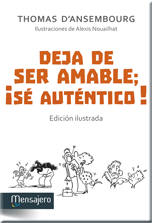 Thomas Ansembourg It is an international reference in Nonviolent Communication (and a personal reference for me, since my training in the CNV started with him and his accompanying delved). Now he shares his deep understanding of human nature and compassionate view of conflicts with a fully illustrated version (almost comic format) his first book, Stop being nice; I truly!, a bestseller and an inexhaustible resource for reflection.
Thomas Ansembourg It is an international reference in Nonviolent Communication (and a personal reference for me, since my training in the CNV started with him and his accompanying delved). Now he shares his deep understanding of human nature and compassionate view of conflicts with a fully illustrated version (almost comic format) his first book, Stop being nice; I truly!, a bestseller and an inexhaustible resource for reflection.
In this booklet, with illustrations Alexis Nouailhat, so simple and suggestive, Thomas d'Ansembourg his personal history (Chapter 1, “Who is this guy?”), analyzes with humor and clearly some of the basic problems we face as a people (Chapter 2, “Want to get out of the traps?”) and proposes “Some notions of Nonviolent Communication” (Chapter 3) to begin transforming our consciousness (and thereby transform our relationships and our lives), and closes with a successful “conclusions”.
With humor and apparent lightness, This book helps us pay attention to our life, with greater presence and processing capacity. It is a joy that it has released Editorial Mensajero, and it's possible see a sample of the index and some illustrations on their website.
Hope you enjoy it as much as the IM.
Xavier
my article “Play the yes’ in the 'no'” (2011)
14 December 2015.
Tags: CNV, Interpersonal communication, Education, CI Spirals, My Classifieds, For parents, Texts CNV
This weekend I had the honor of participating in the I Congress on Emotional Education Navarra, organized by Formed parents. It was a conference organized with great interest, with great care and a good dose of courage. My presentation was specifically about “Affective education that protects against sexual abuse”, one of the themes that work from Spiral Consulting Children, of which I am a founding member. But in the end there was a panel discussion with questions for all speakers, we were sharing with the moderation of Sonsoles Echevarren, journalist from Diario de Navarra. It was a very interesting time, and although the questions were addressed to each speaker, at the end there were many in which we participate several more. In this context a very interesting question arose, “How do you listen to a child who refuses to leave the park?”. interesting and valuable answers were given, and I brought my contribution: “Listening yes’ in the 'no'”.
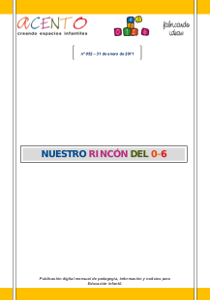 Rescue in this blog because my article 'Listen to “yes” in the “no”‘, which it was published in the number 52 (January 2011) Magazine Our corner of 0-6, published by ACCENT (He continues no longer releasing new numbers, although still available). This article development more broadly what I argued then: When a person (and a boy or girl is also a person) dice “no”, He is saying “yes” many things, and if we listen to the entire message, we can create a deeper connection and find a satisfactory solution for all parties. The article begins:
Rescue in this blog because my article 'Listen to “yes” in the “no”‘, which it was published in the number 52 (January 2011) Magazine Our corner of 0-6, published by ACCENT (He continues no longer releasing new numbers, although still available). This article development more broadly what I argued then: When a person (and a boy or girl is also a person) dice “no”, He is saying “yes” many things, and if we listen to the entire message, we can create a deeper connection and find a satisfactory solution for all parties. The article begins:
mother, two and a half years, She does not want her coat to go outside. Joseph, four years, You do not want to lose the swing to go home. Irene, of five years, He does not want to go to sleep. Why not do those things that as adults we seem perfectly reasonable?
And what do we do next? ¿We yield and do what they want? Then we feel bad because we are not working to their education, and also it gives us the feeling of leaving aside what we as people also want. Would you force them to do what we want? Then we have guaranteed discussion and bad environment for a long time, long term and we are teaching them that in the end the important thing is to have power or strength, and that dialogue only serves when it is weak. In my personal and professional experience there is a third way, based on a deeper communication in each of these situations. And one of the skills that we developed in the workshops I facilitate is the ability to listen to what they say “yes” our children when they say “no”.
Download the full article “listen to the “yes” in the “no”‘
Hope you find it interesting.
Xavier
“Connect with Respect” (“Respect for Me, Respect for You”), Bridget Belgrave material for Nonviolent Communication work with adolescents and young
18 September 2015.
Tags: CNV, Interpersonal communication, Education, Training, In English, Texts CNV, Videos
Last weekend 12 and 13 September 2015 I have had the privilege and pleasure of working again Bridget Belgrave. As I mentioned in this post, I met Bridget Belgrave already Gina Lawrie, Certified trainers for the Center for Nonviolent Communication (Center for NonViolent Communication, CNVC), in 2009 and from that moment we began to work together to translate NVC Dance Floors the Castilian. Completed translations finally saw the light in 2014, with some illustrative videos that can be viewed I made this entry for release. Association for Nonviolent Communication It has organized a series of training courses in Madrid, Bilbao and Barcelona during September 2015, and for me it has been a pleasure to work again with Bridget Belgrave support team with the translation from English into Castilian and vice versa.
In preparing the workshop I have spent time reviewing all the materials I have the NVC Dance Floors and of Bridget en particular. And valuing all materials, each with its wealth, there is one that is still my favorite. In fact, Bridget invited me to share my vision at some point of the workshop, and I happened also to extend my recommendation in this blog.
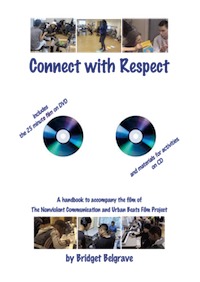 The material in question is only in English and not have subtitles or translations available, but I hope that does not discourage approach him. “Connect with Respect” (“Connect on respect”, literally translated into Castilian) is a multimedia material documenting a project that made Bridget Belgrave 2004 with 21 adolescents and young adults with an average age of seventeen. The project was proposed as an intervention to train boys and girls in situations of social difficulty Nonviolent Communication, within the framework of a workshop building urban rhythms, for ten weeks.
The material in question is only in English and not have subtitles or translations available, but I hope that does not discourage approach him. “Connect with Respect” (“Connect on respect”, literally translated into Castilian) is a multimedia material documenting a project that made Bridget Belgrave 2004 with 21 adolescents and young adults with an average age of seventeen. The project was proposed as an intervention to train boys and girls in situations of social difficulty Nonviolent Communication, within the framework of a workshop building urban rhythms, for ten weeks.
Why recommend? Here is a summary of my reasons:
- The DVD with the film, of 25 minute. Collect the key moments of the project, recorded therefore the three trainers as by young people themselves, and edited in collaboration with them. In fact, as told in a passage, the fact of viewing previous sessions helped them all become more aware of their own learning and getting behaviors that would be well suited to the needs of everyone. It is a graph document lets put faces (and sounds) to different situations, and lets figure out how to apply it in other contexts.
- The video is supplemented with the second part of the book, “Guide to the Film” (“Guide for the film”), on which sequence by sequence discussed everything that happens: each situation, how teaches Nonviolent Communication, Practice times, the real conflicts that arise… This will better understand the intent of each activity and the difficulties encountered and how they were addressed.
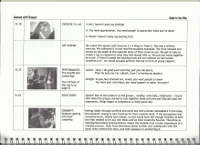
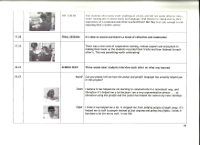
- And the third part of the book contains the complete program, ten weeks with all their detailed exercises and all materials also typeset (English), as well as incorporating a CD-ROM with the file of each material in PDF ready to print. Obviously the video does not collect all the exercises, so it is very useful to see the progression activity to activity, with the ability to replicate.
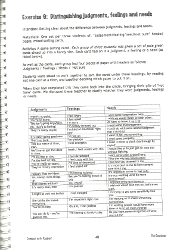
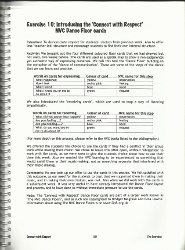
- The availability of a translation of what the Dance floor itself to Castilian, with title “Respect for Me, Respect for You”, within the complete package Dance Floors.
- And the caveat Bridget Belgrave not attempt a project of this type without having one hand a strong background and experience in Nonviolent Communication, and secondly an educational team with some basis of CNV and experienced in working with adolescents. I made some of these exercises with adolescents and youth at risk in Madrid and went well, so I'm available.
In summary, a material worth seeing, read, reread and implement. And you can buy in its online store, Life Resources.
And if you want more clarification, You can call me on my phone contact and discuss what you want.
I hope we can soon have more projects of this style here!
Xavier
Book “Parenting from the heart” de Inbal Kashtan
6 May 2015.
Tags: CNV, Interpersonal communication, Education, For parents, Texts CNV
“According to my experience, the practice of Nonviolent Communication with young children is more a matter of what happens inside me-that way I talk to myself about what is happening with me and my son to negotiate. However, I also want to express in words my understanding of what is happening for both, at least part of the time, even if I think my child does not understand the language, because it helps me connect with the feelings and needs of both. That, at the same time, helps me calm down and find strategies that do work for both. I also want to speak aloud because I think this is the way to acquire language and emotional literacy.” (Inbal Kashtan, Parenting from the heart, page 38)
When people involved in my interpersonal communication workshops have sons or daughters who are in childhood or adolescence, or work with those ages, typically they arise “Yes, This way of communicating is very well among adults, but to see how I tell my son / niece / student / daughter…”. If time, practice communicating with children in training, but often I can only indicate possible suggestions and explorations. We now have a new resource, that lets you family communication to another level. This is not only to resolve conflicts (that also), but to create a more authentic connection type, deeper and more powerful, that prepares children for more resiliently life.
With this sensitivity Inbal Kashtan wrote his book Parenting from the heart. Share the gift of compassion, connection and choice, published last year in Castilian by Editorial Acanto. Inbal Kashtan, forming Nonviolent Communication and mother of a child, he led for years the work of Nonviolent Communication within the family, especially from parents to their children. Inbal died in September 2014, but his legacy continues baynvc (an organization that disseminates Nonviolent Communication from San Francisco Bay, California, of which he co-founded) and his writings (in addition to this book, You can read some of his articles about family communication in English baynvc). This blog also wants to be an acknowledgment and a tribute to his life and work.
I recommend this book both for those who come for the first time to Nonviolent Communication and for those who want to deepen their practice with children. Hope you enjoy the.
Xavier
Restorative Practices at school, a new way to resolve conflicts
5 May 2015.
Tags: CNV, Interpersonal communication, Education, In English, For parents, Texts CNV, Other Texts, Videos, Webs
Most disputes can be resolved in a satisfactory and beneficial way for all parties, provided that the necessary resources and time are dedicated. That's my personal and professional experience years learning, practicing and transmitting Nonviolent Communication. It's as basic (not easy) as the necessary conditions for that resolution occurs. For me there are several must-haves, which can be summarized as follows:
- An appropriate methodology, to allow all parties involved feel safe and respected in their rights.
- Professionals with experiential training in mediation and deep listening skills and “translation” messages to make them easier to listen to each person.
- A supportive community restorative processes, devoting time, spaces, human Resources, training…
- People willing to resolve conflicts in a way that ultimately all parties feel heard and that all parties leave satisfied with the solution.
So for me it is a joy to share the resources developed by a large community of people in the neighborhood are Gotleu in Palma de Mallorca (Mallorca), They are collecting and how they have worked each of those elements.
In this video you can see how they have been involved, with the revitalization of Institute for Coexistence and School Success (the Institute for Coexistence and School Success in Castilian) Government of the Balearic Islands, from the faculty of schools of Primary Education, Elementary and Secondary, students of all ages, the families, and Social Services, police, University and other significant social groups. A mosaic of voices, We make us an idea of the experiences of the creation of that network security in a socially vulnerable environment, and we see some results.
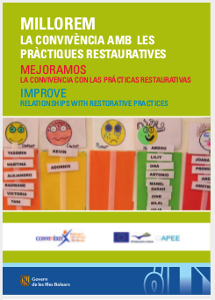 For a more systematic view, is the publication containing the fundamentals. Published in Catalan, Castilian and English as part of a European project this subject, the Guide to improve coexistence with Restorative Practices / Guide Mejoramos coexistence with the practices restorative develops the theoretical aspects of Restorative Practices, more accurate data and provides concrete examples and suggestions for further reading for more information.
For a more systematic view, is the publication containing the fundamentals. Published in Catalan, Castilian and English as part of a European project this subject, the Guide to improve coexistence with Restorative Practices / Guide Mejoramos coexistence with the practices restorative develops the theoretical aspects of Restorative Practices, more accurate data and provides concrete examples and suggestions for further reading for more information.
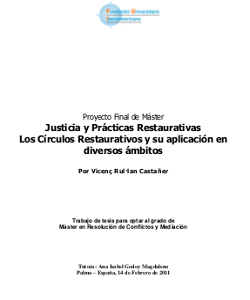 And to deepen the Restorative Circles, a practice of conflict resolution originated in the social dimension Nonviolent Communication, you can read the interesting monograph Justice and Restorative Practices. Restorative Circles and their application in various fields, written by Vicenç Rul·lan, a trainer who I have the pleasure of meeting, on the video and in the Guide, and he is a member of the Association of Restorative Justice Practices and Islands (to page Castilian and in Catalan, with several resources more). A good introduction, to further deepen this particular model. And you can also watch videos (English) on the official website of the creator of the Restorative Circles, Dominic Barter, RestorativeCircles.org.
And to deepen the Restorative Circles, a practice of conflict resolution originated in the social dimension Nonviolent Communication, you can read the interesting monograph Justice and Restorative Practices. Restorative Circles and their application in various fields, written by Vicenç Rul·lan, a trainer who I have the pleasure of meeting, on the video and in the Guide, and he is a member of the Association of Restorative Justice Practices and Islands (to page Castilian and in Catalan, with several resources more). A good introduction, to further deepen this particular model. And you can also watch videos (English) on the official website of the creator of the Restorative Circles, Dominic Barter, RestorativeCircles.org.
Who have done some training of interpersonal communication with me you have seen that ground mention this issue of Restorative Practices. I hope these resources illustrate a little better what you have heard me and I hope to awaken your creativity and your imagination to continue discovering more effective and deeper ways to resolve conflicts in the educational environment, and in any other area.
Xavier
Celebration of the life of Marshall Rosenberg and mourning over his death
18 February 2015.
Tags: Agenda filed, CNV, Interpersonal communication, Texts CNV, Experiences
They are being very poignant day between those who know and practice Nonviolent Communication. Marshall B. Rosenberg, creator of Nonviolent Communication, He has died last 7 February 2015 at the age of 80 years (We celebrated his birthday a few months ago in this post), and those who knew him and those who have learned general model are doing something that taught us: celebrate the events that have covered our needs and allow us to pass the duel of events that have left our unmet needs.
I had the pleasure of formarme with him during the nine days of the International Intensive Training (International Intensive Training, IIT) Switzerland in July and August 2008. Of that training is the photo that I have with Marshall and his wife Valentina, with the added symbolism of the presence of two boys and a girl unrecognizable in the background, that connects with the Marshall gave me encouragement in my work with children, and adolescents (read more details in the original entry).
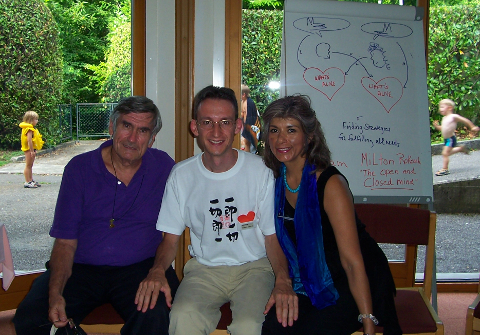
During these days, in which I read the various messages and commemorations that have occurred in the community of Nonviolent Communication, I also took the opportunity to reread the notes I lived those days with him (and in the company of other trainers and other participants). And later it will touch reread all his works, as a way to refresh and honor their work.
Marshall Rosenberg worked to create a more humane world, discovering aspects of life and growth even in the most incomprehensible acts. Your basic sentence is “Violence is a tragic expression of unmet needs”, and the method, Nonviolent Communication, a path to listen and reformulate expressions to find solutions in which all parties are winners.
For me it is especially enriching Marshall's emphasis on social change, he did not want to serve Nonviolent Communication for people he would tarry with her quiet life. The work begins within each person, but you can not stay there, it must reach different structures (economic, social, policies, Education…) and that transform humanizándolas. As he told us in Switzerland: “Our action is similar to that of someone who sees a baby fall down a waterfall and saves, and watching another and saves, and watching another and saves… At some point it will be convenient that person arises who is throwing babies and climb the waterfall to avoid”.
Apart from his writings (more than a dozen books, among them Nonviolent Communication. A language life) and videos and recordings of their workshops and their songs, Marshall leaves constituted the Center for Nonviolent Communication (Center for NonViolent Communication), with a history of decades of work, and that it has been operating without recent years. It also leaves hundreds of certified trainers that their model is still transmitted with fidelity and tens of thousands of practitioners who try to put some light in our daily conflicts. It is something to celebrate.
At the same time, his passing leaves a void. Knowing that he has died at his home accompanied by his wife Valentina and their children is a minor consolation. We know that and we will see not representing new conflict situations, you will not hear any new songs, not write new books. And that alone is host to compassionate the pain and sorrow that appear.
Only by integrating the full experience we can move on fully, integrating the received Marshall and looking, moment by moment, how to update an enriching way for everyone.
In celebration and mourning,
Xavier
NVC Dance Floors: practice Nonviolent Communication in a holistic manner
25 September 2014.
Tags: CNV, Interpersonal communication, Education, In English, My Classifieds, For Teens, For boys and girls, For parents, Psychotherapy, Therapy, Texts CNV, Videos
The NVC Dance Floors have already appeared in the version in Castilian, in which I have worked, and are also available videos subtitled in Spanish.
Bridget Belgrave and Gina Lawrie, Certified trainers for the Center for Nonviolent Communication (Center for NonViolent Communication, CNVC), years they created a great tool to teach and practice Nonviolent Communication (CNV). As they themselves have in submission, the NVC Dance Floors (NVC Dance Floors) They emerged through a series of steps to facilitate the practice of Nonviolent Communication with a spatial maps that allow use body size to work the emotional dimension, the way you see in this video:
In summer 2009 formarme had the pleasure to meet with Gina and Bridget, From there already work resumed translation and adaptation to the Castilian, an effort in which we have helped many people and I have coordinated for a while. So it is a pleasure to spread a simple tool and yet so deep, finally in Spanish, in which we care to include the largest possible number of Spanish version.
My experience is that the NVC Dance Floors the people can practice with just a few initial knowledge of Nonviolent Communication (In fact I sometimes use in introductory workshops). Even people who do not know the process of Nonviolent Communication itself (children, and adolescents, therapy clients) They can easily cross it with help from someone more experienced.
The NVC Dance Floors combine the visual, corporal and language, so that experience occurs through more channels and experience is deeper. And there are nine “dances” different, with names such as “The Dance of the 13 Steps”, “Integration and Dance Connection”, “The Dance of Anger / Rage, Shame and Depression”, “Dance of Yes and No”, The “Transform the pain of unmet needs in the Beauty Needs”.
Further, in 2013 they released some videos that explain three of these dances, in a neat edition that includes Spanish subtitles.
If you want to buy the dance floor CNV in different formats (as a download in PDF, on paper, plasticized version…) and DVDs to learn them at home or in group practice, you can visit its online store, Life Resources.
And if you want to count on me to try the dance floor in one session or in specific workshops, I will be happy to accompany.
I hope you like.
Xavier
Article “Crossing Focusing and Nonviolent Communication” in The Folio 2014 (The Focusing Institute)
25 June 2014.
Tags: Agenda actual, CNV, Interpersonal communication, Focusing, In English, My Classifieds, Texts CNV, Textos Focusing
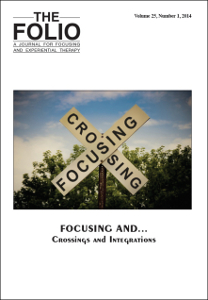 I am happy to share this article that The Focusing Institute has published in The Folio. A Journal for Focusing and Experiential Therapy, its academic journal, in its volume 25 of 2014. My paper “Crossing Focusing and Nonviolent Communication. Reflecting for deeper implications“ appeared at the beginning of 2014 and it has just been published digitally with free access and PDF format in the official website of The Folio.
I am happy to share this article that The Focusing Institute has published in The Folio. A Journal for Focusing and Experiential Therapy, its academic journal, in its volume 25 of 2014. My paper “Crossing Focusing and Nonviolent Communication. Reflecting for deeper implications“ appeared at the beginning of 2014 and it has just been published digitally with free access and PDF format in the official website of The Folio.
[Update February 9th 2017] Download the Japanese version of the article, “The intersection of the focusing and the non-violent communication - towards the deeper implications tell-back”, and read the story of its translation (in Spanish) by Madoka Kawahara (Kawahara circle) y Mako Hikasa (Mako Hikasa). thank you very much!
I leave here the abstract:
ABSTRACT
Both Focusing and Nonviolent Communication (NVC) are based on the idea that people get insights and their inner processes get carried forward when some of their words are reflected. Reflection enhances connection both with oneself and with the companion. And reflection brings deeper implications, as implied aspects come into existence and become conscious.
However, Focusing and Nonviolent Communication put the stress on reflecting different aspects of the original communication. Focusing follows felt senses in the body as a new way to create new meaning. Nonviolent Communication tries to find the universal needs that are at the core of every human action. Focusing and Nonviolent Communication have been crossed in different ways (a short revision of some crossings is explored in this paper). Focusing can be enriched by introducing a new awareness for needs, especially when Asking. And Nonviolent Communication can be enhanced by a new sensitiveness to the original expressions of the person –not just trying to “translate” everything, but also valuing habitual language as metaphors.
When both processes are combined and the companion/therapist reflects aspects of both levels of awareness, the person achieves relevant results as deep implications emerge.
Keywords: Focusing, Nonviolent Communication (NVC), Empathy, Reflect, Crossing.
For Spanish speakers, Go to this post in Spanish.
I hope that you will enjoy it and I will love reading your comments,
Xavier
Artículo “Cómo combinar Focusing y Comunicación NoViolenta” en el Folio 2014 de The Focusing Institute
25 June 2014.
Tags: Agenda actual, CNV, Interpersonal communication, Focusing, My Classifieds, Texts CNV, Textos Focusing
 With great joy I share this article that I published The Focusing Institute (International Focusing Institute based in New York) volume 25 corresponding to 2014 of The Folio. A Journal for Focusing and Experiential Therapy, official academic journal. Appeared in the paper version earlier 2014, my article “Crossing Focusing and Nonviolent Communication. Reflecting for deeper implications“ It has just been published in English in free access in PDF on the official website The Folio.
With great joy I share this article that I published The Focusing Institute (International Focusing Institute based in New York) volume 25 corresponding to 2014 of The Folio. A Journal for Focusing and Experiential Therapy, official academic journal. Appeared in the paper version earlier 2014, my article “Crossing Focusing and Nonviolent Communication. Reflecting for deeper implications“ It has just been published in English in free access in PDF on the official website The Folio.
[update 9 February 2017] Download the Japanese version of the article “The intersection of the focusing and the non-violent communication - towards the deeper implications tell-back” and see the translation history.
And I also leave the initial summary:
SUMMARY
Focusing as both Nonviolent Communication (CNV) They are based on the idea that people get insights and our processes are carried forward when we reflect some of our words. The reflection power connection of the person with herself and who accompanies. And the reflection carries deeper implications while the implicit aspects open to their own existence and are recognized consciously.
However, Focusing and Nonviolent Communication They emphasize reflect different aspects of the original communication. Focusing follows heartfelt feelings in the body as a new way to create new meaning. Nonviolent Communication tries to find the needs universal human that underlie every human action. Focusing and Nonviolent Communication They have combined (crossed) in different ways (a brief review of some combinations are explored in this article). Focusing can be enriched by introducing a new awareness of the needs, especially in passing Ask. And the Nonviolent Communication You can promote a new sensitivity to the original terms of person-not just trying to "translate" all, but also valuing the common language as a set of metaphors.
When the two processes are combined and when the listener as a coach or therapist reflects aspects of both levels of consciousness, the person achieves relevant results to emerge profound implications.
Keywords: Focusing, Nonviolent Communication (NVC) / Nonviolent Communication (CNV), Empathy, Reflect, Crossing/Cross / Combine.
For English speakers, go to this post in English.
I hope you enjoy it and be happy to read your comments,
Xavier
Upgrade 26 September 2014:
I had the honor of the Castilian version of my article appearing in the page in Spanish Focusing Institute in New York (The Focusing Institute). Thank you! Thank you very much!
Upgrade 9 February 2017:
Very grateful for the Japanese translation of Madoka Kawahara (Kawahara circle) y Mako Hikasa (Mako Hikasa). thank you very much! Aquí está la translation history.
